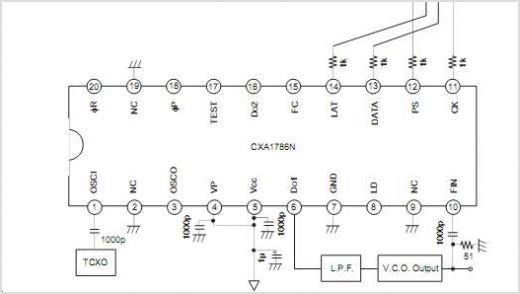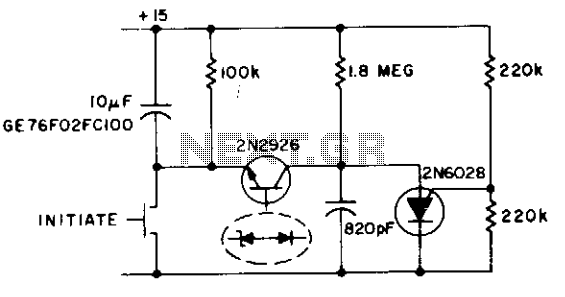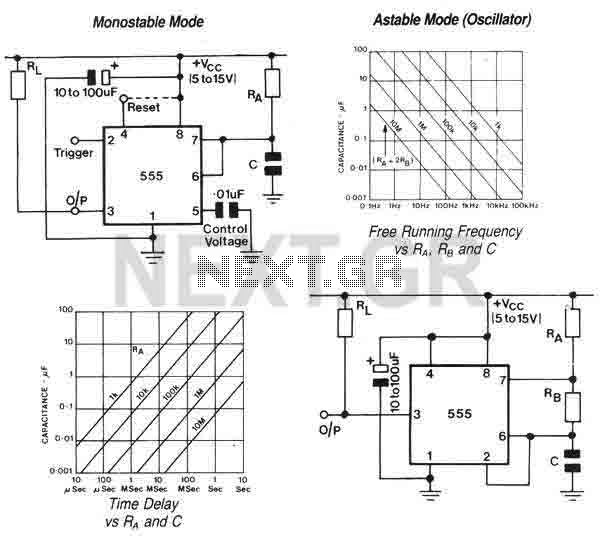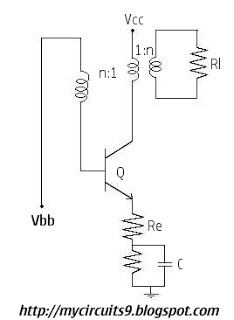
phase locked loop pll oscillator
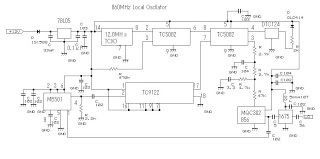
This 860 MHz Phase Locked Loop (PLL) oscillator circuit is designed for a 1200 MHz transverter's local oscillator with 435 MHz rigs. The oscillator circuit utilizes Toshiba PLL synthesizer ICs. The TC9122P is a user-friendly preset counter for determining the desired frequency value through patching. The TC5081AP functions as a phase comparator, while the TC5082P serves as a binary counter for dividing by 2048. The TC5082P also incorporates a crystal oscillator circuit. A 12.8 MHz signal is divided by 2048 to yield 6.25 kHz. The MB501 acts as a 64 dividing prescaler. The input of the TC9122P must be patched for 2150, resulting in a frequency calculation of 6.25 kHz * 2150 * 64, which equals 860 MHz. The voltage-controlled oscillator (VCO) is manufactured by MURATA, designated as MQC-302-856. The loop filter employed is a simple lag-lead filter. The output RF signal is amplified by a monolithic microwave integrated circuit (MMIC). The uPC1675G is not suitable for this application; the MAR-3 is recommended instead. The uPC1675G has a PiMAX of 0 dBm, leading to an output power of 4 dBm, while the MQC-302-856 outputs 1 dBm, which is excessive. By using the MAR-3, an RF output of 11 dBm can be achieved. This local oscillator (LO) is intended for use in a 1200 MHz to 435 MHz converter, combined with a TUF-5 double-balanced mixer (DBM). The TUF-5 requires a +7.5 dBm LO input for maximum conversion gain. Additionally, a pad should be placed at the input of the DBM to reduce distortion. An output level of 11 dBm is considered adequate.
This circuit design integrates key components to facilitate the generation of a stable 860 MHz signal suitable for transverter applications. The TC9122P preset counter allows for easy frequency selection, enabling flexibility in adjusting the output frequency based on user requirements. The phase comparator TC5081AP ensures that the phase of the output signal remains locked to the reference frequency, enhancing the stability of the oscillator.
The binary counter TC5082P effectively divides the input frequency, and its integration with a crystal oscillator ensures precise frequency control. The choice of a 12.8 MHz crystal allows for efficient division to achieve the necessary 6.25 kHz reference frequency. The MB501 prescaler further reduces the frequency to a manageable level for the PLL circuit, ensuring that the TC9122P operates within its optimal range.
The VCO, MQC-302-856, is selected for its performance characteristics, providing a reliable output that meets the power requirements of the application. The simple lag-lead filter serves to smooth the output signal, reducing phase noise and improving overall signal quality. The amplification stage, utilizing the MAR-3 MMIC, is crucial for achieving the desired output power while maintaining linearity and minimizing distortion.
The integration of the TUF-5 DBM in the design allows for efficient frequency conversion, with the specified LO input level ensuring optimal performance. The inclusion of a pad at the DBM input is a critical design consideration, as it protects against distortion and ensures that the mixer operates within its linear range. Overall, this PLL oscillator circuit represents a well-engineered solution for applications requiring precise frequency generation and conversion in the specified frequency bands.This 860 MHz Phase Locked Loop (PLL) oscillator circuit is for 1200 MHz transverter`s local oscillator with 435MHz rigs. The oscillator circuit uses PLL synthesizer IC`s of Toshiba for PLL circuit. TC9122P is easy to use preset counter for determining request frequency value by patching. TC5081AP is phase comparator and TC5082P is binary counter f or 2048 dividing. TC5082P has also been consited of Xtal oscillator circuit. 12. 8MHz is divided by 2048 into 6. 25Khz. MB501 is a 64 dividing prescaler You must patch the input of TC9122P for 2150, and 6. 25kHz*2150*64 comes to 860MHz. Parts VCO made by MURATA as MQC-302-856. The loop filter is simple lag-lead filter The output RF signal is boosted by MMIC. The uPC1675G is not suitable for this level, you may use MAR-3 instead. Because the uPC1675G`s PiMAX is 0dBm and then Po:4dBm, MQC-302-856`s output of 1dBm. is over power. If you use MAR-3 instead you will get 11dBm of RF output. I would like to use this LO for 1200 MHz to 435 MHz converter and combining with TUF-5 DBM. TUF-5 asks +7. 5dBm LO input for MAX conversion gain. And on the input of DBM there should be placed PAD for decreasing distortion. 11dBm output level is adequate, so I think. 🔗 External reference
This circuit design integrates key components to facilitate the generation of a stable 860 MHz signal suitable for transverter applications. The TC9122P preset counter allows for easy frequency selection, enabling flexibility in adjusting the output frequency based on user requirements. The phase comparator TC5081AP ensures that the phase of the output signal remains locked to the reference frequency, enhancing the stability of the oscillator.
The binary counter TC5082P effectively divides the input frequency, and its integration with a crystal oscillator ensures precise frequency control. The choice of a 12.8 MHz crystal allows for efficient division to achieve the necessary 6.25 kHz reference frequency. The MB501 prescaler further reduces the frequency to a manageable level for the PLL circuit, ensuring that the TC9122P operates within its optimal range.
The VCO, MQC-302-856, is selected for its performance characteristics, providing a reliable output that meets the power requirements of the application. The simple lag-lead filter serves to smooth the output signal, reducing phase noise and improving overall signal quality. The amplification stage, utilizing the MAR-3 MMIC, is crucial for achieving the desired output power while maintaining linearity and minimizing distortion.
The integration of the TUF-5 DBM in the design allows for efficient frequency conversion, with the specified LO input level ensuring optimal performance. The inclusion of a pad at the DBM input is a critical design consideration, as it protects against distortion and ensures that the mixer operates within its linear range. Overall, this PLL oscillator circuit represents a well-engineered solution for applications requiring precise frequency generation and conversion in the specified frequency bands.This 860 MHz Phase Locked Loop (PLL) oscillator circuit is for 1200 MHz transverter`s local oscillator with 435MHz rigs. The oscillator circuit uses PLL synthesizer IC`s of Toshiba for PLL circuit. TC9122P is easy to use preset counter for determining request frequency value by patching. TC5081AP is phase comparator and TC5082P is binary counter f or 2048 dividing. TC5082P has also been consited of Xtal oscillator circuit. 12. 8MHz is divided by 2048 into 6. 25Khz. MB501 is a 64 dividing prescaler You must patch the input of TC9122P for 2150, and 6. 25kHz*2150*64 comes to 860MHz. Parts VCO made by MURATA as MQC-302-856. The loop filter is simple lag-lead filter The output RF signal is boosted by MMIC. The uPC1675G is not suitable for this level, you may use MAR-3 instead. Because the uPC1675G`s PiMAX is 0dBm and then Po:4dBm, MQC-302-856`s output of 1dBm. is over power. If you use MAR-3 instead you will get 11dBm of RF output. I would like to use this LO for 1200 MHz to 435 MHz converter and combining with TUF-5 DBM. TUF-5 asks +7. 5dBm LO input for MAX conversion gain. And on the input of DBM there should be placed PAD for decreasing distortion. 11dBm output level is adequate, so I think. 🔗 External reference
